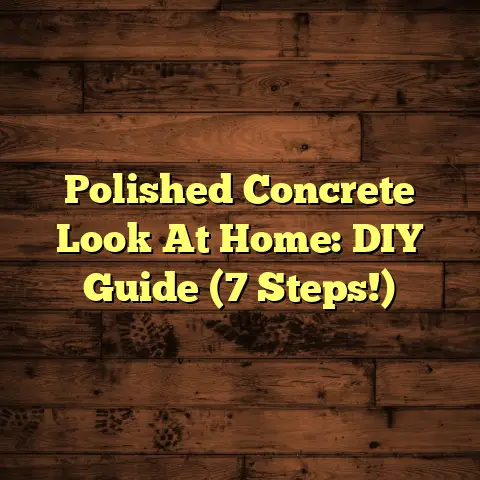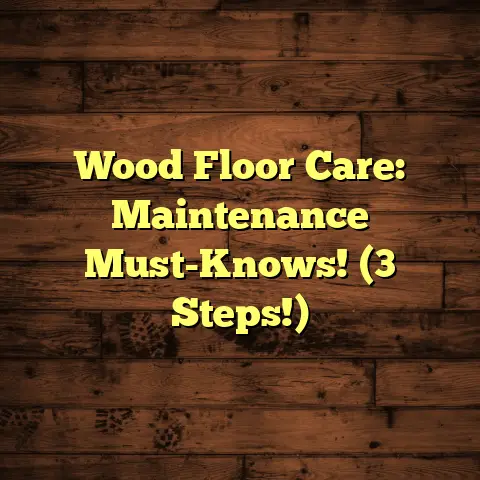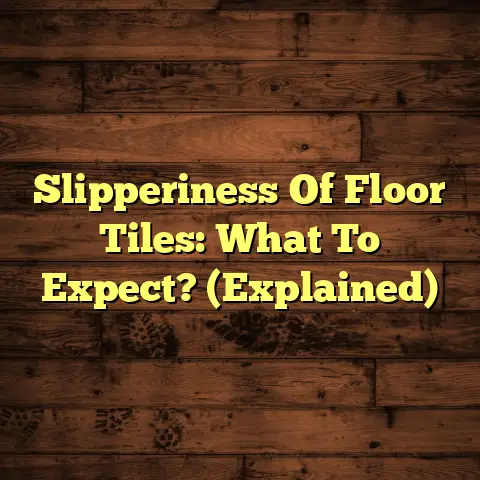Termites & Laminate: The Truth? (1 Pro’s Warning)
Picture this: You’re strolling into your living room, admiring your beautiful laminate flooring, when suddenly, you notice something’s off.
A slight buckle here, a warp there.
You bend down for a closer look,
and that’s when you see it—tiny tunnels,
little piles of droppings.
Your heart sinks.
Could it be?
Termites?
This very moment of realization is why
I’m writing this article.
Let’s dive deep into the truth about termites and laminate flooring, separating fact from fiction.
Section 1: Understanding Laminate Flooring
Okay, so what exactly is laminate flooring? Think of it as a layered cake.
Each layer plays a crucial role:
- Wear Layer: The top layer, a transparent coating that protects against scratches and stains.
- Design Layer: This is where the magic happens.
A high-resolution image of wood, stone, or tile gives laminate its realistic look. - Core: Usually made of high-density fiberboard (HDF) or medium-density fiberboard (MDF), providing stability and impact resistance.
- Backing: The bottom layer, offering moisture resistance and balance.
Laminate’s popularity stems from its affordability
and aesthetic appeal.
It mimics the look of hardwood
without the hefty price tag.
Installation is relatively straightforward,
often using a click-lock system.
A typical lifespan?
With proper care, you can expect
10-20 years of beauty and durability.
Section 2: The Anatomy of Termites
Now, let’s talk about the villains of our story: termites.
These tiny creatures can cause big headaches.
There are several types, but the most common culprits are:
- Subterranean Termites: These guys live in the soil and build mud tubes to reach food sources above ground.
- Drywood Termites: They infest dry wood, like furniture and structural beams, without needing contact with the soil.
- Formosan Termites: The most aggressive species, known for their large colonies and destructive appetite.
Termites are social insects, living in colonies with
different castes: workers, soldiers, and reproductives.
Their diet?
Cellulose, which they get from wood.
Signs of infestation include:
- Mud Tubes: Earth-colored pathways built along walls or foundations.
- Discarded Wings: Piles of wings near windows or doors, indicating swarming activity.
- Frass: Termite droppings, which look like tiny pellets.
Section 3: The Interaction Between Termites and Laminate Flooring
Here’s the million-dollar question: Can termites infest laminate flooring?
The short answer is: not directly.
Termites don’t eat the wear layer or the design layer.
Their primary target is the wood components,
like the HDF or MDF core.
However, laminate flooring isn’t entirely immune.
Termites can still cause problems by attacking
the underlying structures.
Think about it: Your laminate is likely installed
over a subfloor, which is often made of plywood.
If termites infest the subfloor,
they can compromise the stability
and integrity of your entire flooring system.
Moisture and humidity play a significant role.
Damp conditions create an inviting environment
for termites and wood-decaying fungi,
making the subfloor more vulnerable.
If you have a wooden subfloor,
your laminate is definitely at risk.
Concrete subfloors offer some protection,
but termites can still find ways to access
wooden structures within your home.
Section 4: Myths and Misconceptions
Let’s bust some myths, shall we?
Myth #1: Laminate flooring is termite-proof.
False!
While the surface layers are resistant,
the core and underlying structures are still susceptible.
Myth #2: Termites only eat solid wood.
Nope. They’ll happily munch on the wood fibers in laminate cores and subfloors.
Myth #3: If I have laminate, I don’t need to worry about termites.
Big mistake. Ignoring potential infestations can lead to costly repairs down the road.
I’ve seen countless cases where homeowners assumed their laminate was safe, only to discover extensive termite damage to the subfloor and surrounding structures.
For instance, I had a client in Atlanta
who noticed a slight dip in her laminate floor.
She dismissed it as normal settling,
but when I pulled up the flooring,
we found a massive subterranean termite colony
had completely devoured the plywood subfloor.
The damage was so severe that we had to replace
the entire subfloor and treat the surrounding soil.
Laminate offers less food to termites
compared to solid wood flooring.
But termites will still infest it if there is
an accessible wooden component.
Section 5: The Pro’s Warning
I had a chat with my friend, Bob Vila (not the Bob Vila, but a top-notch pest control expert I know).
His warning was crystal clear:
“Don’t ignore the early signs of termite activity!
Laminate can hide the damage until it’s too late.”
He shared a story about a homeowner
in Southern California who noticed
some buckling in their laminate flooring.
They assumed it was a moisture issue
and didn’t investigate further.
Months later, when they finally called
a pest control company,
they discovered that Formosan termites
had completely hollowed out the wall studs
behind the laminate.
The repair costs were astronomical.
Bob emphasized that regular inspections are crucial,
especially in areas prone to termite infestations.
He also recommended investing in professional
termite treatments to protect your home.
Section 6: Preventative Measures
While laminate itself doesn’t attract termites, taking preventative measures is essential.
Here are some tips:
- Regular Inspections: Schedule annual termite inspections with a qualified pest control company.
- Moisture Control: Fix leaks promptly, ensure proper drainage, and use dehumidifiers in damp areas.
- Ventilation: Ensure adequate ventilation in crawl spaces and attics to prevent moisture buildup.
- Landscaping: Keep mulch and vegetation away from your foundation, as these can attract termites.
- Soil Treatment:
Consider treating the soil around your foundation
with a termiticide.
This creates a barrier that prevents termites from entering your home. - Boric Acid Treatment:
Boric acid is a natural and effective
termite control solution.
It can be applied to wood surfaces to kill termites on contact.
It’s safe for humans and pets when used as directed, making it a popular choice for homeowners.
Section 7: Conclusion
So, what’s the bottom line?
While termites don’t directly feast on laminate, they can still cause significant damage by attacking the underlying structures.
Don’t be lulled into a false sense of security.
Stay vigilant, be proactive,
and protect your investment.
Remember, awareness and vigilance are key
to maintaining a healthy and termite-free home.
Don’t wait until it’s too late.
Your home will thank you for it.





